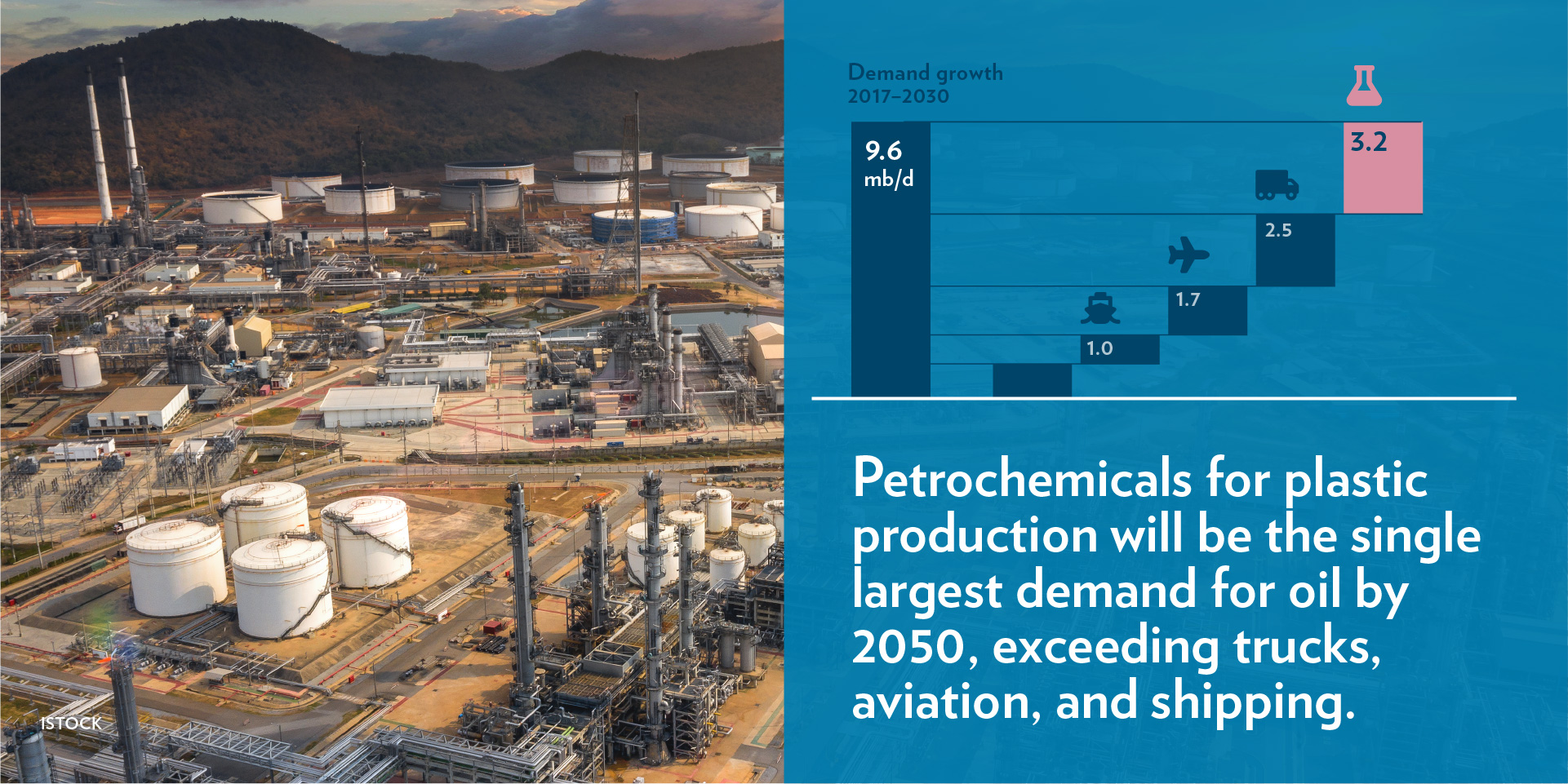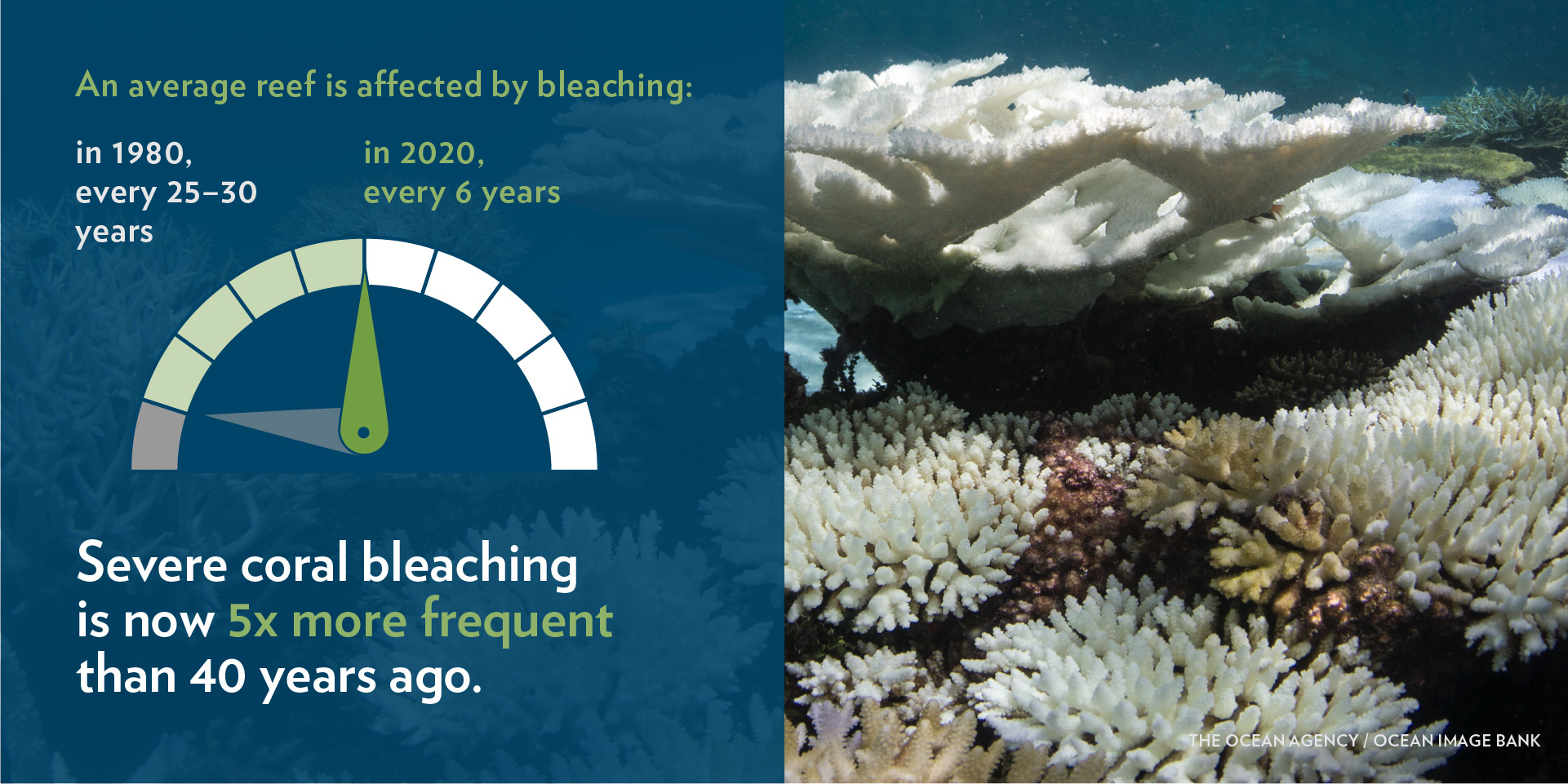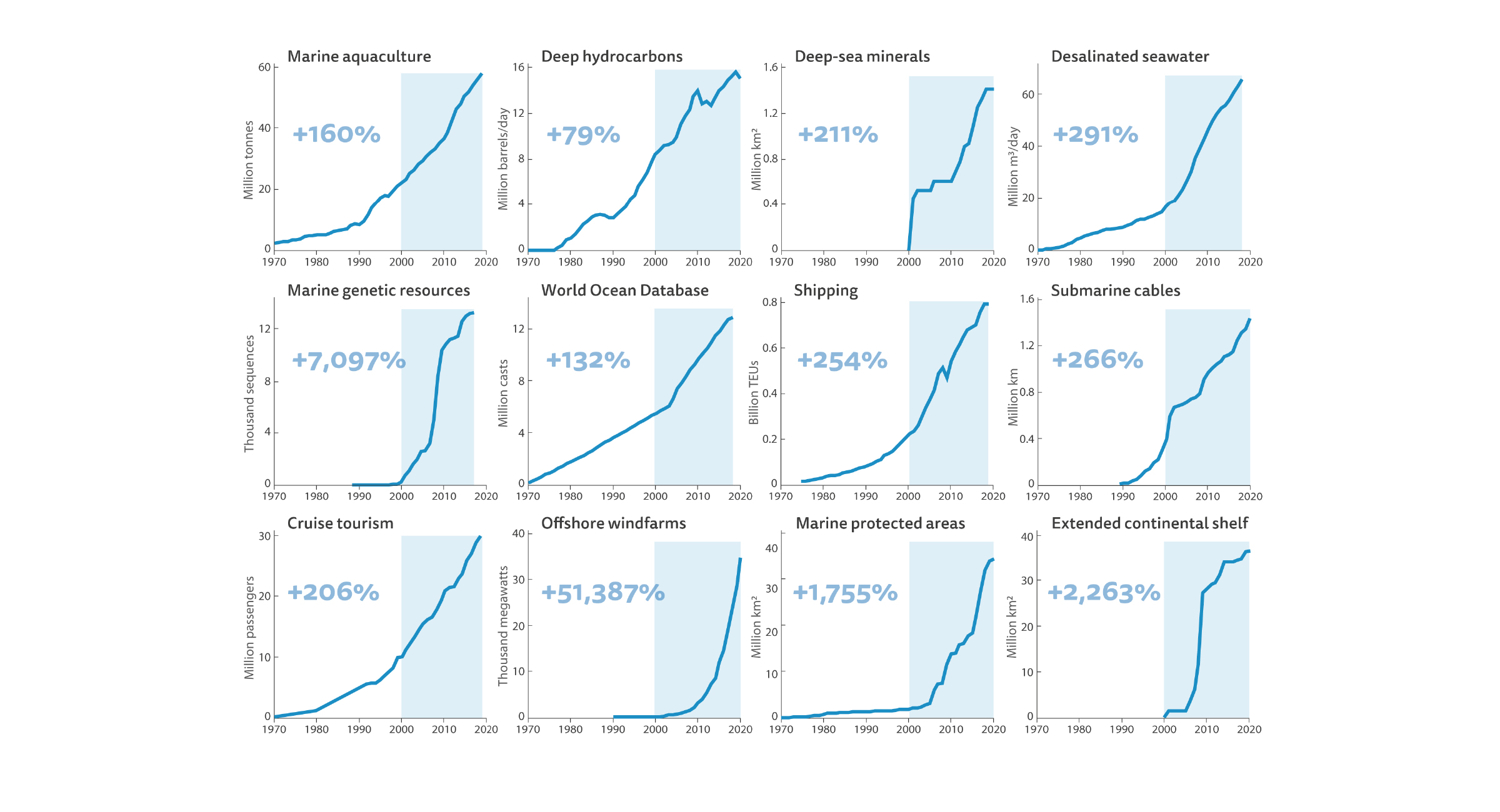Jump to:
Executive Summary
For several decades, the human footprint on the ocean has been expanding due to climate change, overfishing, coastal development and associated habitat loss and pollution, and the combined activities of marine industries—particularly shipping and oil and gas but also emerging industries such as deep-sea mining.1 The combined threats to the ocean are cumulative, are sometimes difficult to document (e.g., scale of pollutants), and can interact with each other in unpredictable ways.
The following high-level trends point to recent and ongoing changes in the ocean. Readers are invited to explore additional statistics and analysis by topic area, shared in greater depth in the respective chapters on this site.
Climate Change
Climate change represents the fastest-growing and most intense threat facing the global ocean.2,3 Impacts of climate change are more pronounced and occurring earlier than scientists predicted even a decade ago.4 The fingerprint of human-induced climate change is perhaps most evident in the ocean. As the Earth’s largest heat sink, the global ocean has warmed at unabated levels since 1970, absorbing more than 90 percent of excess heat energy.5 The rate of ocean warming has more than doubled since 1993.6 Increased emissions have disproportionately impacted the ocean, which captures about 25 percent of anthropogenic CO2 emissions emitted annually and will ultimately store most of that carbon.7 On the whole, the ocean is higher, warmer, stormier, more acidic, and has less oxygen due to climate-induced changes.
The six hottest years on record for the upper ocean have all occurred since 2015 due to continued increases in greenhouse gas emissions.8 Ocean heat content is considered one of the best indicators of climate change, given that the ocean stores the bulk of excess global warming heat.9
Climate and weather-related extremes have trended steadily upwards, often unfurling the greatest damage on communities that have done the least to cause the climate crisis. A record number of hurricanes, wildfires, and floods exacerbated by climate change cost USD 280 billion worldwide in 2021 and claimed over 10,000 lives.10
Sea level rise is a direct consequence as the planet warms, ice sheets and glaciers melt, and warming sea water expands. Warming in the Arctic is occurring at almost twice the global average.11 New research shows that global vulnerability to sea level rise is worse than previously understood. Analysis suggests that by 2050, rising sea levels could push chronic floods higher than land which is currently home to 300 million people, with the threat most concentrated in coastal Asia.12
Unsustainable Fishing and Farming
Wild fisheries and aquaculture production provide important contributions to food security and livelihoods globally. Fish provide a source of protein for about 3.3 billion people, playing a particularly crucial role in many developing countries and coastal communities.13 However, wild capture and aquaculture activities—if not practiced sustainably—can threaten marine wildlife, habitats, and the livelihoods and food security of seafood-dependent communities.
The long-term trend in total global capture fisheries has been relatively stable since the mid-1990s. According to the Food and Agriculture Organization (FAO), which estimates landings primarily based on self-reporting from national governments, wild fisheries production was 79 million tonnes in 2019, a slight reduction from the 18-year high of 83 million tonnes in 2018.14
The status of fisheries resources varies significantly by geography and is closely related to the level of fisheries management. For the half of the world’s fish catch for which abundance data are available, there has generally been an uptick in the biomass of fish stocks in recent years.15 In contrast, unassessed stocks are believed to have continued to decline. In several countries, reduction in fishing pressure is directly associated with fisheries management policy changes.
In 2021, the Minderoo Foundation released the Global Fishing Index (GFI) to assess the governance and sustainability of the world’s fisheries. During the inaugural year of the GFI, no country received an ‘A’ or ‘B’ grade based on the state of fish stocks and local governance systems. Six countries were assigned a ‘C’ grade while 20 countries received an ‘F’ grade.16 The Fisheries Management Index (FMI), which also assesses management effectiveness, was last updated in 2018 and found that FMI scores continue to hold a strong positive correlation with GDP per capita and a negative correlation with capacity-enhancing subsidies.17
While marine fisheries landings have generally plateaued since the mid-1990s, aquaculture has driven continued growth in global seafood production. The aquaculture sector has seen many dynamic changes over the past two decades, one of which includes transitioning from a relatively small role to a more mainstream role in the global food system. In 2019, production from brackish and marine aquaculture reached a record-high of 32 million tonnes, growing at a combined growth rate of 4.4 percent during 2015–2019.18 (Meanwhile, production from capture fisheries expanded at a slower rate of 0.1 percent during the same time period.)19
China continues to produce more aquaculture than the rest of the world combined. Other major producers include India, Indonesia, Vietnam, Bangladesh, Egypt, Ecuador,20 and Norway. Despite China’s dominant role in the aquaculture sector, growth rates in South America and Africa have been strikingly high during the past two decades, pointing to the growing globalization of the sector.

Pollution
The ocean is often considered the final dumping ground for society’s wastes: over 80 percent of land is in a watershed that drains directly into the ocean.21 Industrial, agricultural, and municipal wastes all eventually find their way to the ocean in the form of toxic chemicals, nutrients, pathogens, and trash. While some of this waste is highly visible (e.g., oil spills and large plastics), other types are less conspicuous but similarly insidious (e.g., toxic chemicals, nutrients, and microplastics). The aggregate effect of all pollution on the marine environment is not fully known due to the diffuse nature of sources and incomplete data, but indicators suggest that it is likely worsening. Pollution threats tend to be most acute in coastal and nearshore habitats.
The plastic waste crisis continues to accelerate, with the flow of plastic into the ocean projected to nearly triple by 2040 under business-as-usual projections. Plastic pollution is not only an ocean issue; the growing role of emissions from plastics is one of the key blind spots in the global energy debate. Petrochemicals used to make plastic are increasingly becoming the largest driver of global oil consumption, expected to account for more than a third of the growth in oil demand to 2030 and nearly half to 2050—more market share than trucks, aviation, and shipping.22 The plastic waste crisis is increasingly becoming an environmental justice challenge, as the impacts of pollution disproportionately affect structurally marginalized communities—in high- and low-income countries alike.
The large-scale input of nutrients is increasing globally due to persistent pollution from agriculture, livestock, and sewage. A seminal study released in 2021 was the first of its kind to map nitrogen inputs from wastewater pollution in 130,000 watersheds around the world.23 That study found that wastewater contributes nearly half as much nitrogen to our ocean as does agriculture and livestock.

Habitat and Biodiversity
Evidence suggests that marine habitats and biodiversity are showing rapid ongoing declines, as humans have significantly altered two-thirds of the ocean (up from 40 percent in 2008).24 According to the most recent assessment from the Intergovernmental Science-Policy Platform on Biodiversity and Ecosystem Services (IPBES), approximately one million plant and animal species (including marine and terrestrial combined) are threatened by extinction, many within decades.25 The current rate of extinction is tens to hundreds of times higher than the average over the past 10 million years, and it is accelerating.26
Estimating the loss of marine biodiversity and habitat is as much about what we do not know as what we do know. It is estimated that only 10-25 percent of marine species have been described globally.27 The lack of baseline data and long-term monitoring also remains a challenge in tracking the status of both species and habitats. Among marine habitats, an estimated 30-50 percent of vulnerable marine habitats have been lost, with patterns of loss accelerating in recent decades.28 The degradation and loss of marine habitats are not uniformly distributed and tend to face cumulative, yet poorly understood, interactions between multiple threats.29,30
To address losses in biodiversity and marine habitat, the international community has increasingly focused on the protection of marine areas and the mitigation of both local and global threats. For several decades, MPA coverage hovered around 1 percent. The rate of MPA designations increased rapidly in recent years as governments raced to meet a global target of 10 percent ocean protection by 2020. As of mid-2022, nearly 8 percent of the ocean is protected.31 Through the Conference of the Parties 15 (COP15), government are in the process of developing a post-2020 global framework for biodiversity. The current target language includes a global goal to protect at least 30 percent of the ocean by 2030.
The Blue Acceleration

Adapted by: Jouffray J-B, Blasiak R, Nyström M, Österblom H, Tokunaga K, Wabnitz CCC, Norström AV (2021) Blue Acceleration: an ocean of risks and opportunities. Ocean Risk and Resilience Action Alliance (ORRAA) Report.
Industrial Impacts
The level of industrial activity on the ocean is expected to increase in coming years. According to the OECD, ocean industries generated USD 1.5 trillion in economic activity in 2010; this amount is expected to double to USD 3 trillion in 2030.32 Some sources refer to the trendline of human expansion into the ocean as the “Blue Acceleration.”33 As diverse and sometimes competing user groups seek to access food, material, and space in the ocean, there are calls to carefully consider concerns around equity and sustainability.
There are several industries (both long-standing and emerging) that are active on the ocean. Shipping and offshore oil and gas represent the two largest sectors economically and have the most significant ecological footprint on the marine environment outside of fishing. Among sectors with a smaller but still notable footprint, marine aquaculture has grown rapidly over the last two decades. Several other industries—including marine renewables, deep-sea mining, and biotechnology—are on the horizon.
Funding
In 2021, Our Shared Seas published the most comprehensive report on the state of ocean funding to characterize the philanthropic response to ocean threats. The analysis found that approximately USD 3.1 billion in funding was allocated to marine conservation globally from philanthropic, development aid, NGO discretionary funding, and private finance sources in 2019.34 Philanthropic funding for marine conservation has doubled over the past decade, from roughly USD 520 million in 2010 to USD 1.2 billion in 2020.35 New entrants into the sector and growing commitments from existing funders are driving the increase in ocean funding.
Top areas of marine grantmaking over the past decade have included science (21 percent) and protected areas and habitat protection (17 percent).36 Ocean-climate is an emerging area of grantmaking. Foundation funding for the ocean-climate nexus grew from USD 3.6 million in 2010 to nearly USD 50 million in 2020. Marine conservation grantmaking has historically allocated a large proportion of funding to global initiatives (40 percent) and work focused on North America (32 percent). Over the past decade, an increased proportion of marine funding (15 percent) was allocated to Asia. Funding to Africa remains limited, at less than 3 percent of philanthropic funding.37
Historically, philanthropy and the development sectors have focused their respective funding on different parts of the world. Over the past decade, marine philanthropy allocated the largest proportion of its funding to global initiatives (35 percent) and North America (30 percent) over the past decade, whereas the development sector focused primarily on Africa (33 percent) and Asia (25 percent).38 However, addressing marine and fisheries in Asia has become an increasing priority for many ocean funders. Asia was the third highest recipient of marine philanthropic funding during 2010-2020, suggesting a potential shift by philanthropy to tackle ocean challenges beyond North America.
Explore trends in further depth by reviewing each threat chapter on Our Shared Seas.
Notes
- Halpern, B. et al. (2019). Recent Pace of Change in Human Impact on the World’s Ocean. Scientific Reports 9, no. 1: 11609.
- Casey C. O’Hara, Melanie Frazier, Benjamin S. Halpern. At-risk marine biodiversity faces extensive, expanding, and intensifying human impacts. Science, 2021; 372 (6537): 84 DOI: 10.1126/science.abe6731.
- Halpern, B. et al. (2019).
- Diffenbaugh, N.S. 2020. Verification of extreme event attribution: using out-of-sample observations to assess changes in probabilities of unprecedented events. Science Advances 6: 2368.
- IPCC, 2019. “Summary for Policymakers. In: IPCC Special Report on the Ocean and Cryosphere in a Changing Climate.” [H.-O. Pörtner, D.C. Roberts, V. Masson-Delmotte, P. Zhai, M. Tignor, E. Poloczanska, K. Mintenbeck, M. Nicolai, A. Okem, J. Petzold, B. Rama, N. Weyer (eds.)].
- Ibid.
- Ibid.
- Cheng, L. J., and Coauthors, 2021: Upper ocean temperatures hit record high in 2020. Adv. Atmos. Sci., 38(4), 523−530, https://doi.org/10.1007/s00376-021-0447-x.
- Cheng, L., Abraham, J., Trenberth, K.E. et al. Another Record: Ocean Warming Continues through 2021 despite La Niña Conditions. Adv. Atmos. Sci. 39, 373–385 (2022). https://doi.org/10.1007/s00376-022-1461-3.
- Munich Re. “Hurricanes, cold waves, tornadoes: Weather disasters in USA dominate natural disaster losses in 2021.” https://www.munichre.com/en/company/media-relations/media-information-and-corporate-news/media-information/2022/natural-disaster-losses-2021.html. January 10, 2022.
- Thoman, R.L., J. Richter-Menge, and M.L. Druckenmiller, Eds.., 2020: Arctic Report Card, 2020, https://doi.org/10.25923/mn5p-t549.
- Kulp, S.A., Strauss, B.H. New elevation data triple estimates of global vulnerability to sea-level rise and coastal flooding. Nat Commun 10, 4844 (2019). https://doi.org/10.1038/s41467-019-12808-z.
- FAO. 2020. The State of World Fisheries and Aquaculture 2020. Sustainability in action. Rome. https://doi.org/10.4060/ca9229en.
- Ibid.
- RAM Legacy Stock Assessment Database. 2018. Version 4.44-assessment-only. Released December 12, 2018. Accessed May 20, 2018. Retrieved from DOI:10.5281/zenodo.2542919.
- Minderoo Foundation, 2021. “The Global Fishing Index: Assessing the sustainability of the world’s marine fisheries.” Perth, Western Australia, 60 pp.
- Ibid.
- FAO. 2021. FishStatJ Manual. Version 4.01.8. Accessed December 6, 2021.
- Ibid.
- Naylor, R.L., Hardy, R.W., Buschmann, A.H. et al. “A 20-year retrospective review of global aquaculture.”
- Lehner, Bernhard, and Günther Grill. “Global River Hydrography and Network Routing: Baseline Data and New Approaches to Study the World’s Large River Systems.” Hydrological Processes 27, no. 15 (July 15, 2013): 2171–86. https://doi.org/10.1002/hyp.9740.
- IEA. “The Future of Petrochemicals.” Paris: IEA, 2018. https://www.iea.org/reports/the-future-of-petrochemicals.
- Tuholske C, Halpern BS, Blasco G, Villasenor JC, Frazier M, Caylor K (2021) Mapping global inputs and impacts from of human sewage in coastal ecosystems. PLoS ONE 16(11): e0258898. https://doi.org/10.1371/journal.pone.0258898.
- IPBES. “IPBES Global Assessment Summary for Policymakers.” 2019.
- Ibid.
- Ibid.
- Rogers, A., O. Aburto-Oropeza, et al. 2020. “Critical Habitats and Biodiversity: Inventory, Thresholds and Governance.”
- IPBES. “IPBES Global Assessment Summary for Policymakers.” 2019.
- McCauley, D. J. et al. Marine defaunation: animal loss in the global ocean. Science 347, 1255641 (2015).
- Halpern, B.S., M. Frazier, J. Afflerbach, J.S. Lowndes, F. Micheli, C. O’Hara, C. Scarborough, and K.A. Selkoe. 2019. “Recent Pace of Change in Human Impact on the World’s Ocean.” Scientific Reports 9 (August): 11609. https://doi.org/10.1038/s41598-019-47201-9.
- Ibid.
- OECD. “The Ocean Economy in 2030.” OECD Publishing, Paris, 2016. http://dx.doi.org/10.1787/9789264251724-en.
- Jouffray, J.-B., R. Blasiak, A.V. Norström, H. Österblom and M. Nyström. 2020. “The Blue Acceleration: The Trajectory of Human Expansion Into the Ocean.” One Earth 2 (1): 43–54.
- Analysis by CEA Consulting, 2021. Prepared for “Our Shared Seas: Global ocean data and trends for informed action and decision-making.” 2021.
- Ibid.
- Ibid.
- Ibid.
- Ibid.
